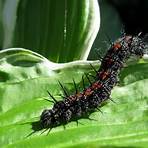

The Mourning Cloak Butterfly
By Jill Staake
Some folks still have snow on the ground, but others are starting too see signs of spring. A friend of mine in Washington DC commented on Facebook that his daffodils are blooming, and recent reports say ruby-throated hummingbirds and monarch butterflies are on the way north once again. In many parts of the country, one of the first signs of spring is the return to the sky of Mourning Cloak butterflies.
Mourning Cloaks (Nymphalis antiopa) can be seen in most parts of the country, with the exception of southern Florida. They are a medium-sized butterfly, with a wingspan of about 3 inches. They are easy to identify, with velvety-brown wings bordered in white or yellow, edged with bright blue spots. Mourning Cloaks are one of the first butterflies to be spotted each spring because most do not fly south when the weather gets cold – instead, they overwinter as adult butterflies tucked away in sheltered places like cracks in rocks or holes in trees. They are able to shut down their bodies all winter long, experiencing a type of hibernation that is known in insects as torpor. When the weather begins to warm up, these butterflies awake and head out to find water and food.
Because these butterflies often emerge in early spring before much in the way of flowers and nectar are available, Mourning Cloaks have evolved to take advantage of other food sources. In early spring, these butterflies are found sipping running sap from tree trunks on sunny afternoons, head down and walking downward. Later in the season, they will very occasionally visit flowers for nectar, but are often seen enjoying rotting fruit, their second favorite food.
How can you attract a butterfly to your garden if it rarely visits nectar flowers? One good place to start is by planting their host plants instead. Mourning Cloak butterflies lay eggs on trees in the willow family, and also on elm and birch. Look for their caterpillars in late spring and early summer. You can also attract the butterflies with very ripe or rotting fruit set in a dish in your garden, like bananas and strawberries. (Set the fruit in a shallow dish of water to deter ants.)